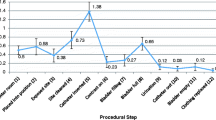Abstract
Background
Undergoing voiding cystourethrogram (VCUG) can be distressing for children.
Objective
To assess the efficacy of a cartoon and photograph montage storybook in preparing children for VCUG.
Materials and methods
Outpatient children (ages 2–14 years) who had VCUGs between December 2011 and June 2012 were randomly assigned to two groups; one group received the storybook a week before the procedure. Parents and guardians were asked to complete an anonymous survey rating their child’s tolerance of the exam from 1 to 5, worst to best, immediately after VCUG. The VCUG technologist also rated the child’s tolerance.
Results
Children prepared for VCUG with the storybook had less distress than those without. Results were analyzed by Cochran-Mantel-Haenszel and Cochran-Armitage Trend exact tests, a P value of both tests of 0.0092 indicating a statistically significant difference between the tolerance scores of children prepared with the storybook and those without. Effects of gender and history of VCUG were not statistically significant. Two-thirds of all children had no other source of information.
Conclusion
The cartoon and photograph montage storybook format of preparing children for VCUG was effective in increasing their tolerance for the procedure. The storybook should be mailed out in advance because the majority of families did not pursue information on preparing their children for VCUG.



Similar content being viewed by others
References
Agrawalla S, Pearce R, Goodman TR (2004) How to perform the perfect voiding cystourethrogram. Pediatr Radiol 34:114–119
Stashinko EE, Goldberger J (1998) Test or trauma? The voiding cystourethrogram experience of young children. Issues Compr Pediatr Nurs 21:85–96
Herd DW (2008) Anxiety in children undergoing VCUG: sedation or no sedation? Adv Urol doi. doi:10.1155/2008/498614
Sandy NS, Nguyen HT, Ziniel SI et al (2011) Assessment of parental satisfaction in children undergoing voiding cystourethrography without sedation. J Urol 185:658–662
Herd DW, McAnulty KA, Keene NA et al (2006) Conscious sedation reduces distress in children undergoing voiding cystourethrography and does not interfere with the diagnosis of vesicoureteric reflux: a randomized controlled study. AJR Am J Roentgenol 187:1621–1626
Chesson RA, Good M, Hart CL (2002) Will it hurt? Patients’ experience of X-ray examinations: a pilot study. Pediatr Radiol 32:67–73
Zerin JM, Shulkin BL (1992) Postprocedural symptoms in children who undergo imaging studies of the urinary tract: is it the contrast material or the catheter? Radiology 182:727–730
Phillips DA, Watson AR, MacKinlay D (1998) Distress and the micturating cystourethrogram: does preparation help? Acta Paediatr 87:175–179
Srivastava T, Betts G, Rosenberg AR et al (2001) Perception of fear, distress and pain by parents of children undergoing a micturating cystourethrogram: a prospective study. J Paediatr Child Health 37:271–273
Blount RL, Landolf-Fritsche B, Powers SW et al (1991) Differences between high and low coping children and between parent and staff behaviors during painful medical procedures. J Pediatr Psychol 16:795–809
Phillips D, Watson AR, Collier J (1996) Distress and radiological investigations of the urinary tract in children. Eur J Pediatr 155:684–687
Zelikovsky N, Rodrigue JR, Gidycz CA et al (2000) Cognitive behavioral and behavioral interventions help young children cope during a voiding cystourethrogram. J Pediatr Psychol 25:535–543
Pediatric Voiding Cystourethrogram. American College of Radiology. http://www.radiologyinfo.org/en/info.cfm?pg=voidcysto&bhcp=1. Accessed November 2011
Stokland E, Andréasson S, Jacobsson B et al (2003) Sedation with midazolam for voiding cystourethrography in children: a randomised double-blind study. Pediatr Radiol 33:247–249
Handford M (1987) Where’s Waldo? Little Brown, Boston
Rey HA, Rey M (1973) Curious George goes to the hospital. HMH Books, Boston
Bemelmans L (2000) Madeline. Viking Juvenile, New York
Random.org (1998) Haahr, Mads. Accessed Nov. 16, 2011
Cole J, Degan B (1986) The Magic School Bus at the waterworks. Scholastic, New York
Hickman MS, White WL, White WA (2010) Illustrations as a patient education tool to improve recall of postoperative cataract medication regimens in the developing world. Hawaii Med J 69:212–215
International Medical Corps (2005) Pilot education program applies LeapFrog® technology to improve the health of rural Afghan women. internationalmedicalcorps.org/page.aspx?pid = 1355. Accessed November 2011
Van Renen C (2011) Having their say: engaging with contemporary picture books at work and at play. J Lit Stud 27:1–25
Grös DF, Antony MM (2006) The assessment and treatment of specific phobias: a review. Curr Psychiatry Rep 8:298–303
Blumenthal I (2006) Vesicoureteric reflux and urinary tract infection in children. Postgrad Med J 82:31–35
Sargent MA (2000) What is the normal prevalence of vesicoureteral reflux? Pediatr Radiol 30:587–593
Acknowledgment
The authors would like to thank Elizabeth and Benjamin Gebarski for their assistance creating the storybook.
Conflicts of interest
None
Author information
Authors and Affiliations
Corresponding author
Rights and permissions
About this article
Cite this article
Gebarski, K.S., Daley, J., Gebarski, M.W. et al. Efficacy of a cartoon and photograph montage storybook in preparing children for voiding cystourethrogram. Pediatr Radiol 43, 1485–1490 (2013). https://doi.org/10.1007/s00247-013-2713-2
Received:
Revised:
Accepted:
Published:
Issue Date:
DOI: https://doi.org/10.1007/s00247-013-2713-2




